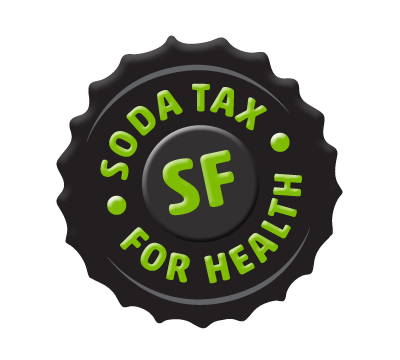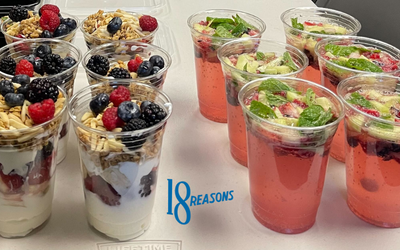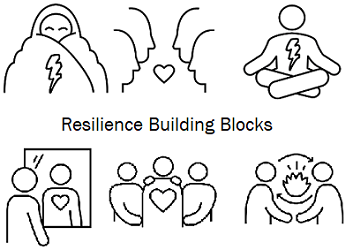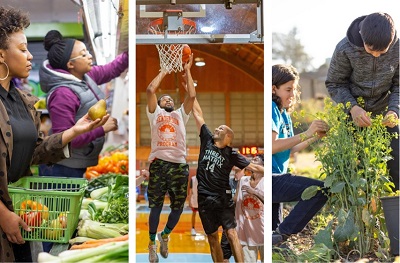By Jennifer Dhillon, CEO/Founder of Bounce Back Generation. Jennifer Dhillon is the CEO and Founder of Bounce Back Generation, one of the inaugural recipients of the Healthy Communities Grants funded by the soda tax. In this guest blog post, Jennifer shares findings from youth surveys and focus groups of youth about how they were coping with the effects of the pandemic, societal stress and trauma, and relates the findings to BBG’s Resilience Building Blocks.
In early 2022, Bounce Back Generation asked a group of young people living in San Francisco and East Bay neighborhoods how they were feeling. We focused on what they experienced during the height of the pandemic and how they were looking at life as COVID began to recede. We wanted to assess their resilience—or how they felt they were “bouncing back” from such a deeply challenging time.
Bounce Back Generation (BBG) works with youth who live in public housing and low-income areas. From our pre-pandemic work, we knew that a range of factors were contributing to decreases in the emotional, psychological and social well-being of young people. Gun violence, poverty, systemic racism, academic and school-related issues, bullying and social media use were already taking their toll. When we conducted tests for Adverse Childhood Experiences (ACEs) to this population, rarely did we record fewer than four ACEs. A score of four or more ACEs is connected with low academic and workplace achievements and mental and physical health problems later in life.[1]
[1] https://centerforyouthwellness.org/health-impacts/#:~:text=The%20higher%20your%20ACE%20score,stroke%2C%20cancer%2C%20and%20diabetes.
In late January 2022, we conducted 15 surveys and a focus group discussion with youth (ages 15 to 23) from the neighborhoods we serve. The goal of our outreach was to assess how well kids were coping by matching up how many were connected to resilience factors in their lives. Resilience, or the ability to “bounce back” after a traumatic event is more likely when we have certain life skills and conditions. These are exemplified in BBG’s Resilience Building Blocks: Protection, Relationships, Coping Skills, Confidence, Belonging and Storytelling. Through our work in high-stress communities, our training in trauma studies, and guidance from mental health professionals, we have identified these six key factors that help build our capacity to bounce back. We use them to teach resilient responses to toxic stress and trauma so that young people gain more personal awareness and joy in their lives-while potentially avoiding cognitive, emotional, and physical health harms associated with toxic stress and trauma.
Here are some highlights of what they shared with us.
We wanted to find out how the pandemic affected them emotionally and academically. We asked the participants to answer “Yes”, “No”, or “I don’t know” to the statement:
I feel my emotions got in the way of learning sometimes because I was unhappy, feelinglonely, anxious, or stressed during the lockdowns.
Close to 75% of respondents said “Yes”.
The remainder of the questions help us to understand whether they had those “Building Block” resilience factors in their lives to help them bounce back.
Protection
We all need places at home, school and in the neighborhood where we can feel protected. Lacking that safety means that a person may feel vulnerable or on high alert. Feeling unsafe can produce anxiety, which can lead to unwanted behaviors like being antisocial, acting out in aggressive and violent ways, or self harming.[2]
[2] https://www.centerforanxietydisorders.com/what-is-self-harm/
Survey question: During the pandemic did you have a place to go where you could express your emotions, relax, and feel safe and not anxious?
More than 50% of participants said “No.”
For those who said they did have a protected space, we asked them to explain more about that space.
“The pandemic gave me the push I needed to remodel my childhood room that I still live in, and I’ve been able to make my own space mine again.” Female, 19, African American
Respondents who didn’t feel safe discussed how this affected them:
“During the pandemic I felt like I had no one and no one cared about me.” Female, 18, African American
“I became more depressed and more closed off.” Female, 23, Mixed Race
“I broke down a few times, did some terrible things to people I care about and now I have to deal with some of those consequences.” Male, 21, Latinx
The last comment is instructive for those of us seeking to help reduce youth violence and self harm. When we feel unsafe and unprotected, our fight-or-flight responses can be triggered—leading to behaviors we often don’t know how to control, much less understand.[3]
[3] https://www.childwelfare.gov/topics/preventing/preventionmonth/about/protective-factors-aces/
We asked: Do you feel like you can ask for what you need emotionally or physically from friends and family?
A little over 65% said yes, they had someone to turn to. We have found that family and community connections can be strong in neighborhoods we serve.
“Yeah, because I trust and love them so I can talk to them.” 16, Male, African American
Yet, many felt their relationships were not as supportive as they needed. We got several responses like this:
“Honestly, I’m not sure. I’m still trying to find myself and I’m not sure what I need, but at the same time my answer is ‘yes’ because when I have my panic attacks there is somebody always in my corner ready to help me.” Female, 22, African American
But, answers like this highlight the need for greater understanding of what our youth need:
“I feel like I can ask most of my friends and family, but sometimes they don’t have the expertise or the ability to help with everything.” 19, Female, Mixed Race
Overall, we were heartened to find that so many of the young people who participated did feel some level of support and love around them, even if there were limitations to what those relationships could provide. This comment summed it up well:
“To an extent. When it comes to family, I have to keep in mind that there is a limitation as my parents are from a vastly different generation and culture than the one I grew up in. When it comes to emotional and mental health, it’s not talked about.” 22, Male, Latinx
COPING SKILLS
This building block teaches that there are a range of coping strategies—and what works for one person may not work for another. Both young and old turn to drugs, alcohol, or risky behaviors to cope with stress. While these may offer relief in the short term, they can make people feel worse later. Our motto is, “A good coping tool makes you feel good today and better tomorrow.”
We asked: Are the tools you use to cope satisfactory to help you manage your stress when it comes up? Or are they only partially or temporarily effective?
A third of our respondents said their coping strategies are “partially or temporarily effective.”
“The tools I use to cope when the stress comes up are temporarily satisfactory. Just for that moment when I’m stressing I would feel better, but after that all my thoughts would come back to me and I would feel bad or sad all over again.” 18, Female, African American
“I don’t really have any tools. I smoke my problems away.” 22, Female, African American
Less than 25% reported to us that they had some level of useful coping skills. Here are some examples:
“Couple of deep breaths to regroup and listening to music to calm myself down and separate from other distractions.” 16, Female, African American
“Yes, they are fully satisfactory when stress comes up.” 19, Male, African American
“The tools I use are decent but I still struggle with motivation and focus a lot which can lead to further stress and anxiety.” 19, Female, European American
CONFIDENCE
Confidence or self-efficacy, the belief we have the ability to affect the world around us with our actions, also help us manage how we deal with stress or recover from trauma. Building confidence is an ongoing process and challenge during middle school, high school, and early adulthood.[4]
[4] https://www.ncbi.nlm.nih.gov/pmc/articles/PMC5878202/
Our question sought to understand whether the participants achieved moments where they felt confident, accomplished or effective in their actions.
We asked: Is there something you do that makes you proud when you’ve accomplished it or finished it?
Several respondents listed finishing homework and completing chores as a sense of accomplishment. Others talked about their creative interests and physical activities:
“Working on my car always is a challenge because it’s often new to me. Seeing the finished work makes me take pride in my effort and the level of perfection I try to reach.” 21, Female, Asian American/Pacific Islander
“Yeah, go on my run at night.” 15, Male, African American
“When I finally hit that high/low note in a song or when the runs come out perfectly…music is and will always be my escape. It doesn’t always work though.” 22, Female, African American
“Yes, when I finish a gift for my parents it makes me proud.” 19, Male, African American
BELONGING
Belonging is about feeling connected to people who accept us as we are. It is a basic human need that is terribly tested when we feel loneliness or suffer from bullying.
We asked: “Please list at least 2 communities, groups, or places that you frequently interact with that understand you or are interested in the same things as you. This can be done virtually or in person. For example, church, online friend group, a gym .”
Twenty percent of participants said they didn’t have a group they felt connected to. Of the roughly 80% who did feel connected and accepted they mentioned the Boys and Girls Club, their friend/family group, or school. These spaces highlight the value of shared community programs. Interestingly, almost half cited some use of technology— like group chats, group texts, and online games—to feel connected to others.
“Me and all my friends have one big group chat and we do mental health check-ups with each other on Sundays and Saturdays. And sometimes we have mid-week check-ins just to see how things are going.” 22, Female, African American
“I have a friend group I often play video games with, and I have friends in my automotive technology classes.” 21, Female, Asian American/Pacific Islander
“Gym membership and my soccer team.” 22, Female, Mixed Race
We wanted to find out more about how they use the internet and social media to gain new skills or knowledge, but didn’t want to prompt them to say they used technology. This information was vital for us because Bounce Back Generation provides many of our services online.
So we asked them: Do you feel you had opportunities to learn more during the pandemic?
More than half said they did learn more and cited online resources. Of those learned more, only 10% cited using tools other than technology to gain knowledge by, for example, practicing something or reading a book. Most said they learned online or by watching television (e.g. documentaries) aided by the fact that the pandemic left them with time on their hands.
“I was online a lot more and learned about things I was interested in.” 22, Female Asian American/Pacific Islander
“I finished my last year of college online. I’m in my room in my apartment.” 22, Male, Latino
We asked about seeking help through counseling or therapy. Many of the participants told us they wanted to use therapy but found that it was unavailable to them, too expensive, or they didn’t know how to find appropriate help. This comment reflected a common sentiment.
“I think what really places a big factor is the environment offering resources. What helps people, including myself, feel comfortable reaching out for help is going in with the knowledge that I am going to a safe space where people want to help me. Cultivating a space like this is crucial for people to feel comfortable and safe enough to utilize resources.”
22, Male, Latino
We wanted suggestions about how they would ideally like to get emotional and mental health supports. We wanted advice on how we could offer our resources in ways that feel connected and welcoming. We asked, “What is the best way to make mental health resources available to young people?
Their suggestions included:
“Increase the social media outreach, text lines for resources, more youth ambassadors.”
21, Female, Mixed Race
“Having the resources in or close to their communities.” 19, Female, African American
“Make ads just so youth know it’s out there.” 23, Female, Mixed Race
“Showing them that they are there. Social media or emails.” 21, Male, Latinx
“Adhere to them, i.e., use tik tok/social media!” 22, Female, Asian American/Pacific Islander
“Infographics! / hosting safe spaces sessions (even on zoom) / incentivizing like providing free food at workshops.” 22, Male, Latinx
Despite the prevalence of technology use among young people, a few thought social connections in person are still important.
“We need to bring back the Big Brother, Big Sister programs because some kids don’t have older siblings that have possibly been through what they are dealing with right now, and I feel like it would help some kids.” 22, Female, African American
“Providing safe and consistent spaces for young adults to be able to freely express who they are, as well as creating new friendships and exploring new opportunities.” 16, Female, African American
STORYTELLING
Storytelling is the ability to share your experiences, thoughts, and perceptions with and learn from others. This vital component to building emotional and mental resilience requires that we ask ourselves questions like, “What happened?”; “How did I feel at the time?”; and “This is how I changed”.
To “story tell” you don’t always need a lot of time or a rapt audience. Most days we simply need someone to listen. We asked:
Is there someone you have that you can share information with when something happens to you? For example “I got a new job, I’m going to share this with my sister!”
Thankfully, all except two of our participants answered “yes”, they do have someone in their life to tell what happened to them. The remaining two answered “sometimes”.
Through our survey and online focus group discussion we wanted to provide a space for the youth to tell us their stories and we now share those stories with you.
Are the Kids Alright? The answer is our young people are resilient but they could use the help of school, after school and community resources and programs. They all potentially offer some or all of the important Resilience Building Block factors – protection, opportunities for relationship-building, a place to teach healthy coping skills, foster confidence, create places to belong, and provide forums and opportunities for storytelling. These are the essential needs and foundational building blocks for life-long resilience.
Bounce Back Generation creates and shares tools to build resilience. Our new website BBGtv.org (launching February 2023) targets youth 16 to 24 years of age and provides media produced by young people hired from the communities we serve. Teaching tools include the Building Blocks for Resilience, Your Hero’s Journey, mindfulness and meditation, “parts work”, and cognitive behavioral self-care. We partner with organizations that offer online group supports and maintain a list of links for local, state and national hotlines and youth assistance programs. To learn more visit bouncebackgeneration.org and BBGtv.org.






